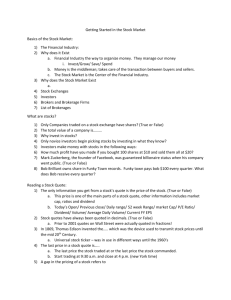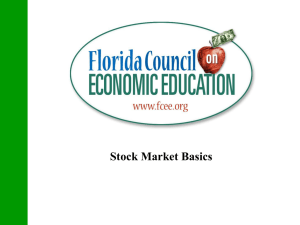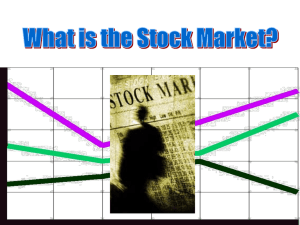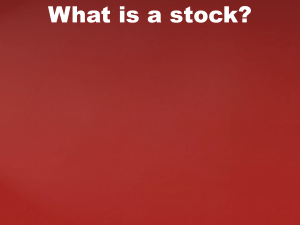HTMW Lesson Plan #1-Introducing the Market to
advertisement
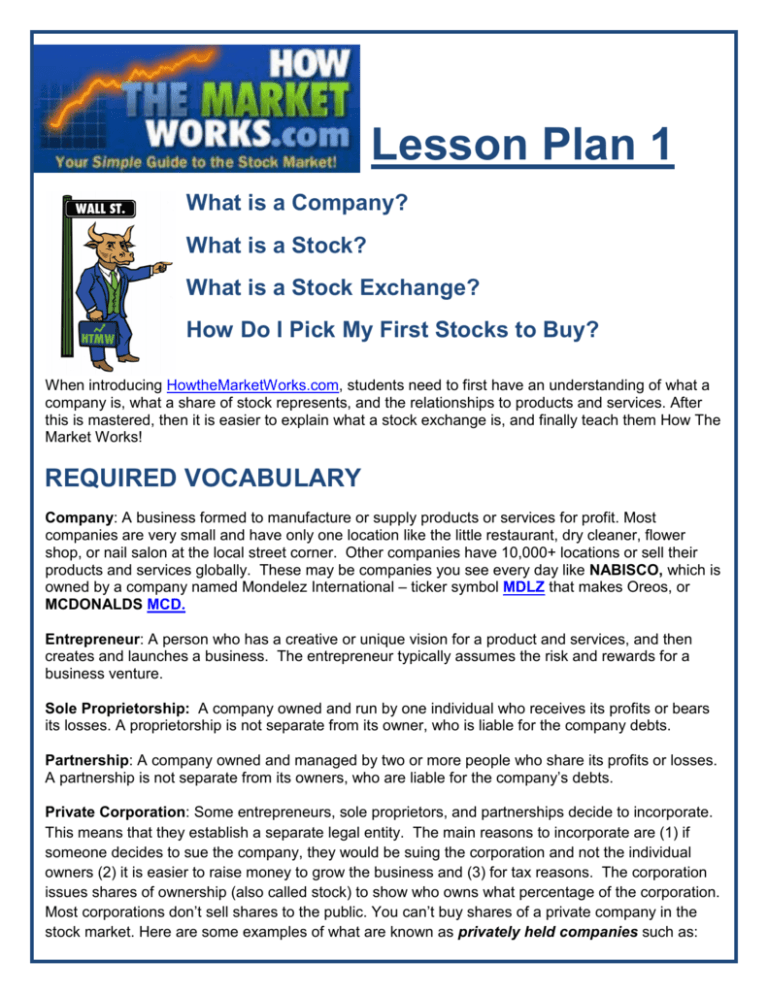
Lesson Plan 1 What is a Company? What is a Stock? What is a Stock Exchange? How Do I Pick My First Stocks to Buy? When introducing HowtheMarketWorks.com, students need to first have an understanding of what a company is, what a share of stock represents, and the relationships to products and services. After this is mastered, then it is easier to explain what a stock exchange is, and finally teach them How The Market Works! REQUIRED VOCABULARY Company: A business formed to manufacture or supply products or services for profit. Most companies are very small and have only one location like the little restaurant, dry cleaner, flower shop, or nail salon at the local street corner. Other companies have 10,000+ locations or sell their products and services globally. These may be companies you see every day like NABISCO, which is owned by a company named Mondelez International – ticker symbol MDLZ that makes Oreos, or MCDONALDS MCD. Entrepreneur: A person who has a creative or unique vision for a product and services, and then creates and launches a business. The entrepreneur typically assumes the risk and rewards for a business venture. Sole Proprietorship: A company owned and run by one individual who receives its profits or bears its losses. A proprietorship is not separate from its owner, who is liable for the company debts. Partnership: A company owned and managed by two or more people who share its profits or losses. A partnership is not separate from its owners, who are liable for the company’s debts. Private Corporation: Some entrepreneurs, sole proprietors, and partnerships decide to incorporate. This means that they establish a separate legal entity. The main reasons to incorporate are (1) if someone decides to sue the company, they would be suing the corporation and not the individual owners (2) it is easier to raise money to grow the business and (3) for tax reasons. The corporation issues shares of ownership (also called stock) to show who owns what percentage of the corporation. Most corporations don’t sell shares to the public. You can’t buy shares of a private company in the stock market. Here are some examples of what are known as privately held companies such as: CARGILL, which makes agricultural products, KOCH INDUSTRIES, which is in many businesses, such as transportation fuels, building and consumer products, and fertilizers, among others., IN AND OUT BURGER, which is a fast food chain, mostly in California, AND MARS, which makes Mars Chocolate bars and other candies. Public Corporation: Larger companies that want to grow quickly often find it easier to sell some of their shares to the public to raise money. The stock of a public company is owned and traded by individual and institutional investors. The stock may also be held by company founders, employees, and sometimes venture capitalists, which are people who invest in new businesses that are just getting started. MCDONALDS Ticker symbol: MCD, VERIZON Ticker Symbol: VZ, Ticker symbol MICROSOFT (MSFT) are all examples of public companies that make products that you may use. IPO or Initial Public Offering: IPO is a term heard a lot on Wall Street and in the news. When a company decides it needs to raise more money and wants to sell it shares to the public, then it files for an IPO. HTMW Investor Tip! Recently we have seen lots of the social media companies like Facebook and Twitter “go public.” While most investors can’t actually buy the shares at the initial offer price, they can buy them once they hit the exchanges and that is often an exciting and volatile day for the new stock price as the average investor finally gets a chance to own some of their favorite companies like Facebook and Twitter! Stock Exchange: Once a company goes public, then the shares of that stock trade on one of the major U.S. stock exchanges (The New York Stock Exchange, the American Stock Exchange, and NASDAQ). The stock exchange is like a flea market where buyers and sellers come together and the buyers try to get an item for as low a price as possible and the sellers try to sell an item for as high as possible. Stock Broker: The stock broker is the person who actually makes the trade for you. In the old days, you would call your broker with your order who would then call his trader on the floor of the NYSE who would then place your order. Today, you can use Etrade.com, Scottrade.com and other online brokerage platforms to make trades. HowTheMarketWorks.com acts just like an Etrade account, with real stocks and real prices, just pretend executions. Sector – A sector is a group of companies that are engaged in similar businesses. For example, McDonald’s and Burger King are in the restaurant sector. General Motors, Ford and Toyota are examples of companies in the automotive (car) sector. Citibank, Bank of America, and Chase are examples of companies in the banking sector. Investor – A person who gives money to any of the above in return for a share of the company. For example, if you and three friends pool your money to make and sell cupcakes at school, you are all investors. THINKING ABOUT COMPANIES STARTING A BUSINESS: So, imagine you started making cupcakes. That’s your product. You make them in your kitchen to sell them at school and your cupcakes get so popular that you couldn’t make enough of them for everyone who wants them, because your oven at home is too small. You might want to start a cupcake factory where you can make enough cupcakes to sell cupcakes to everyone who wants them. Now, to get the money to build the new cupcake factory you would go to people who have money to invest in your business. This could be folks at the bank where you may or may not get a loan. But you have another option: you can go to the stock market and convince people to buy stock in your company. People who buy stock, which are called shares, in your company are called shareholders, because they own a fraction of your company. WHAT IS THE STOCK EXCHANGE AND AN IPO? When a company goes to the stock market for the first time to raise money it’s called an Initial Public Offering, which is also called an IPO. Companies use this money to expand their business, like building a cupcake factory. If you’re the company, you set a price at which you think investors will pay for your stock, after you release the stock into the market to let other people buy a stake in your business, which is called issuance, it is traded on an exchange. The stock’s price will rise or fall based on what investors think it is worth. There are exchanges for stock all over the world. For example, when Google went public in 2004, in other words, they did an IPO and sold shares of the company on the stock market, Google’s initial price was $85. The Google stock traded as high as $1,200 when it spun off another class of shares with $500. Today, it’s worth around $550 to $600 after spinning off a second class of shares that were worth $500 too. That is an incredible return on your investment. Never forget though, the first rule of Wall Street is “Let the buyer beware.” They say this because some companies lose money and eventually go out of business. This means investors’ shares in the company are then worth exactly zero. In the U.S. our largest exchanges are the New York Stock Exchange, which is also known as the NYSE, the other is the NASDAQ, which is an acronym for the National Association of Securities Dealers Automated Quotation System – it was the original computerized stock exchange in the country. The NYSE exchange is where you’ll find larger companies. It began on Wall Street in New York under a buttonwood tree where people would casually gather to buy and sell shares of companies. Today it’s much more organized. It has a building and a trading floor and is tightly regulated by the Federal government to make sure the stocks people buy are actually investments in real companies. These days, like the NASDAQ, you can also buy and sell stocks on the NYSE while sitting at your computer. Smaller companies are generally found on what’s called the NASDAQ, although there can be big companies on the NASDAQ as well, like Microsoft (MSFT). Trading on both exchanges begins at 9:30 am ET and goes to 4:00 pm ET, every weekday, except for holidays. You may hear the term “after hours trading” if you watch some of the financial news stations like CNBC. With How the Market Works you’ll be given a virtual cash amount that your teacher choses ($10,000 to $500,000) to invest in stocks. You will buy and sell shares in the real world with your play money. CLASSROOM ACTIVITIES Buy What You Know! Think about products and services that you, your family, and your friends use every month and think about where you spend their money. Is there a product that you are using more this month than you did a few months ago? Is there a new department store that you are hearing all of your friends talk about? Is there a product that’s HOT that you must have? Try to think about your spending habits in terms of what is necessary, what is nice to have, and what is more of a luxury item. Also think in a company-specific way like this: • • • The Basics: Instead of “going to the store for some food” try thinking like this: Yesterday while wearing my Nike shoes, Levi jeans, and my Abercrombie and Fitch t-shirt, I stopped at the Bank of America ATM to get some cash pay for the BP gas I had to put in my Ford car that was rolling on GoodYear tires so I could drive to the Wal-Mart to buy Charmin toilet paper, Crest toothpaste, Nabisco crackers, Coca-Cola, and Breyers ice cream. On the way home we stopped at McDonalds for a quick bite and then at CVS and Walgreen’s for grandma’s prescription and some Revlon lipstick!) The Nice-to-Haves: On Saturday we stopped at Starbucks coffee on our way to Whole Foods, but then Mom called on my iPhone using the Verizon Network to remind me to get some new Yoga pants at LuLuLemon. the Fun-to-Haves: Over the summer we took a trip on Delta airlines and stayed at the Marriott hotel near Disney so we could shop out the outlet stores --Coach, Tommy Hilfiger, Crocs, Old Navy, and The Gap are my favorites. Now make a list of at least 10 different companies whose products or services you might purchase. Using the HowTheMarketWorks company lookup, see if you can find the stocks of these companies. You might have to use Google or Yahoo to find out “Who makes Oreos” or “Is Kroger a public company?” Of the companies that you can find that are publicly trading, click on the symbol like “F” for Ford Motor Company and write down their ticker symbols and their prices. And then click on “Company” in the green menu bar and write down the Sector and Industry that the stock is in. Try to come up with a list that includes at least 5 different sectors. Use this form to help you research companies and to help you get your portfolio started. TEACHER HELP: Before explaining the parameters of the game, break the students into teams of 2-3 if computer resources allow it. Explain how to participate as a team. For example, they need to make group decisions on the following: • How much to buy? Stress that putting all their money in one stock could lose them everything. This introduces the concept of diversification. • How and when to buy? [Set up a teacher account prior to the lesson and demonstrate the How the Market Works “Buy” function. This also allows you to play along with the students] • How and when to sell? [Using your teacher account, demonstrate how to sell) • Students also need to decide what each team member’s responsibilities are in terms of: • Consensually making trades, (i.e., who will make the trades on the computer and when)? • How many stocks each student will research? This can also be assigned by the teacher. Three to five stocks to begin with is generally a good number. • Will each student be responsible for tracking their portfolio, or will they divide the responsibility on a weekly basis or whatever timeframe is preferable? Once the teams are formed stress that students cannot change teams or team members. Take a few minutes with the class to establish roles, and team rules. For example, one student cannot arbitrarily access the portfolio and buy a stock they want. The team must agree to the purchase and the amount, even if there is a team captain, which you may or may not want to allow. Once the teams are formed, give the students the game’s start and end dates on the chalkboard or as part of a handout you may choose to develop yourself. You may choose to offer a prize for the winning team, such as a pizza party. You may also choose to invite a financial professional from a bank or brokerage into the classroom at some point in the game to talk about the markets and their job. Explain how “HowTheMarketWorks” is played. For example, you can use a variation of the following: “In the game we’re playing, you and/or your team are investing directly in public companies on your computers with the $25,000 of imaginary money you’ve been given. As an investor, it’s important to understand what the company does. This is called ‘buying what you know.’ If you don’t understand what a company does, you should go to that company’s website and research it. Almost every company has an ‘About Us’ section on its website, which can help you get familiar with what the company does. Ask people in your family about companies where they may work. You can also research stocks on the finance sections at Yahoo and Google, where there is usually a link called “Company Description,” which lets you know what the company sells and what they do to make money. Before students purchase or even make a list of companies have them refer back to the Stock Search exercise where students will have saved searched companies, which can be hand-written, printed or saved as a computer file. Many teachers have students keep the results of the exercise in their folders. This will be the starting point for ideas about companies that they want to invest in. You should also introduce risk factors such as low, medium and high. Examples for low risk stocks include very large stable companies such as (AT&T), major utility companies, and publicly traded grocery store chains. You can use a major publicly traded utility or grocery company in your area. If your local Wal-Mart (WMT) sells groceries, it’s a good example. You can explain that these are “low risk”, because they sell things that everybody needs. Most people need a phone, gas for their car (think oil companies, and everyone has to eat, so the likelihood that these companies would go out of business is very small, although the risk still exists. Explain that low risk stocks tend not to move much higher or lower and if you don’t like taking risks, which means you’re a low risk investor, these are good stocks to invest in. The chance that you would lose a large amount or all of your money are pretty small with these stocks although it still exists. Once they understand that concept, move on to medium risk stocks. Explain that medium risk stocks are generally companies that usually sell things that people may or may not need such as Best Buy (BBY), and high risk stocks are those that have not proven themselves, in terms of selling their product, or they have previously failed and gone into bankruptcy – which means the company’s stock went to zero – such as the retailer JC Penney (JCP). Risk: The chance of losing all or part of the value of an investment. Risk Tolerance: An individual investor’s ability to accept loss of some or all of the money they have invested. A person’s risk tolerance is based on a number of factors including age, financial stability, amount of time before the invested funds are needed for other purposes, etc. Volatility: Indicates how much and how quickly the value of an investment, market, or market sector changes. TIMING FOR THIS LESSON: Usually the above outlined lesson can generally be spread out over approximately 2-3 45 minute consecutive class periods. You should review briefly what was covered the day before and continue to make sure there is relevance to your subject. Note: It’s also interesting for the students to mention how the Dow Jones Industrial Average DJIA did for the day, or the previous day depending on the time zone in which you live. Students can be required to keep team folders where they store their handouts and notes. OTHER RECOMMENDED RESOURCES: Remember to explore the Education Center on the HowTheMarketWorks.com website! http://education.howthemarketworks.com/how-to-trade/how-to-trade-stocks/ How Do I Start Investing? How Do I Buy a Stock? The Motley Fool ( 3 minute video) https://www.youtube.com/watch?v=HpELLjrreTA Warren Buffet – How to Turn $40 into $5 Million ( 8 minute video) https://www.youtube.com/watch?v=N9Ny6pjCS-8 How to Invest in Stocks: A Beginner’s Guide to Stock Investing http://www.thestreet.com/topic/47701/how-to-invest-in-stocks.html Investing 101 – Stock Market Investing for the Beginner ( 3 minute video) https://www.youtube.com/watch?v=rIrtQC-pHkY

